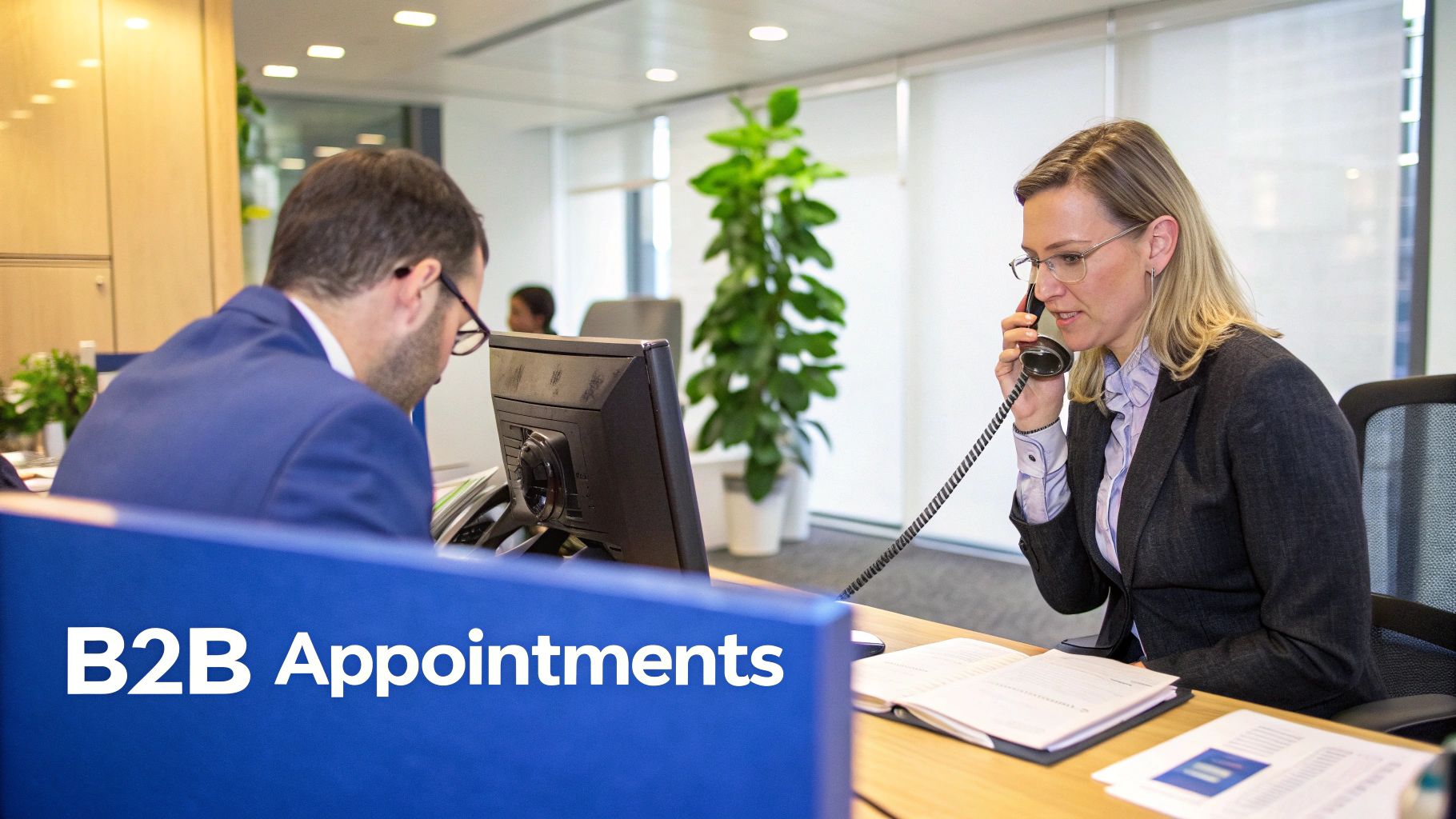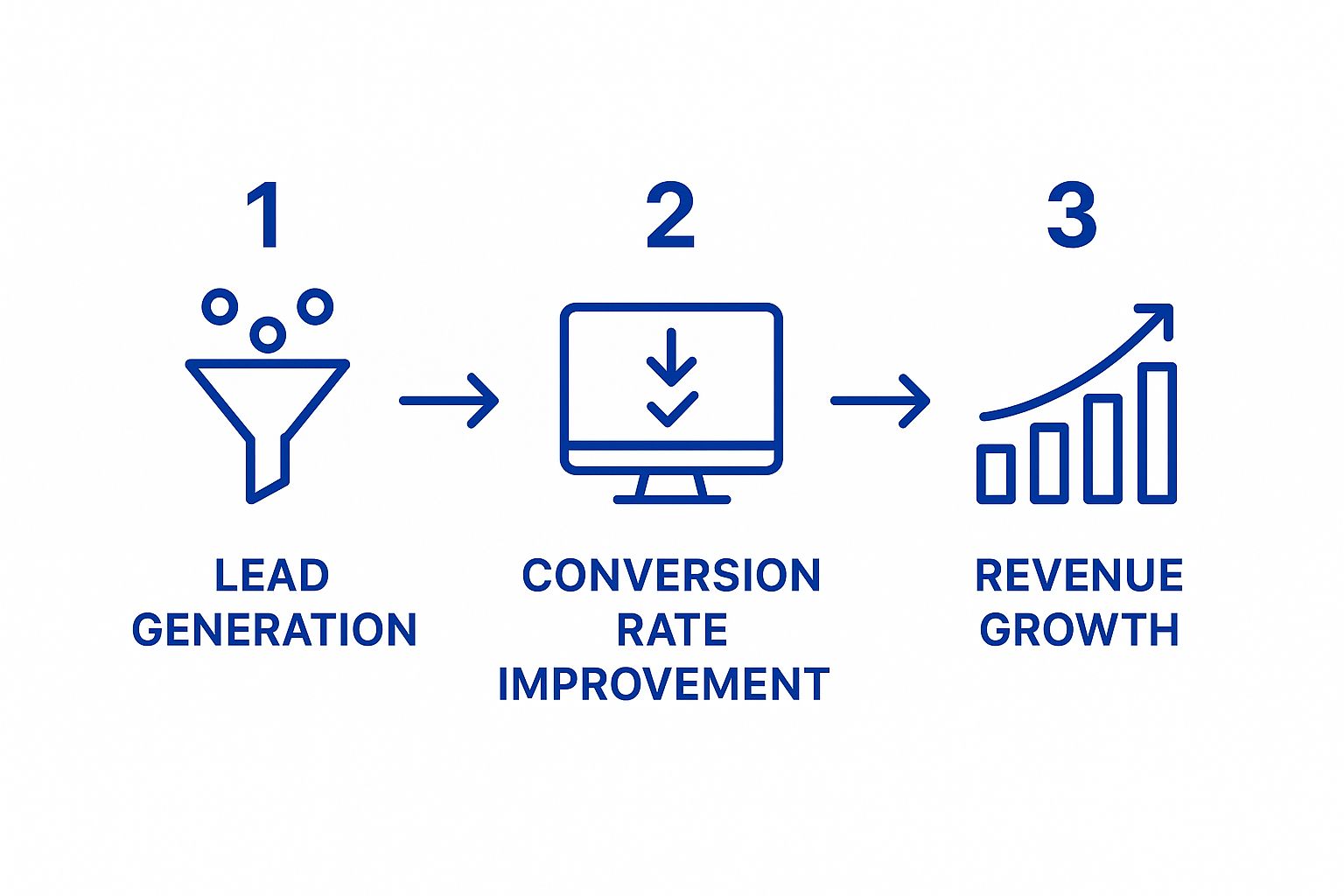Effective appointment setting b2b is not about high-volume cold calling. It is the methodical process of securing meetings between your sales team and qualified decision-makers at target accounts. For sectors like commercial insurance and climate risk, it is the engine driving revenue growth. This guide moves beyond brute-force tactics to a strategic framework of precision targeting and value-driven engagement, designed to fill your sales pipeline with high-intent prospects.
The Modern Playbook for B2B Appointment Setting

Image
Booking meetings with senior underwriters, brokers, and risk managers requires a sophisticated approach. Generic email blasts and outdated scripts are ineffective against today's discerning gatekeepers. Success demands a modern, multi-channel framework that integrates data, technology, and authentic engagement to penetrate a saturated market.
This guide provides that framework. It delivers actionable steps and practical examples tailored specifically for professionals in the commercial insurance and climate risk sectors, eliminating fluff to focus on what drives results.
Key Pillars of a Successful Strategy
Strategic appointment setting is an integral component of your revenue operation, bridging the gap between lead generation and closed deals. For those needing to reinforce the initial stage, explore these proven B2B lead generation strategies.
A modern B2B appointment setting approach is built on four non-negotiable pillars:
- Precision Targeting: Laser-focus on prospects that align perfectly with your Ideal Customer Profile (ICP), ensuring no effort is wasted.
- Value-First Messaging: Craft outreach that demonstrates a clear understanding of the recipient's specific challenges and industry context from the first interaction.
- Systematic Follow-Up: Execute a structured, multi-channel cadence that maintains top-of-mind awareness without becoming intrusive.
- Technology Integration: Leverage appropriate tools to automate administrative tasks and enable personalization at scale.
A successful appointment is a meeting with the right decision-maker where business objectives align and value can be immediately demonstrated. With 60% of B2B buyers now preferring minimal sales interaction, every touchpoint must be impactful.
This guide provides a playbook to master each pillar, transforming your outreach from a speculative activity into a predictable source of qualified sales meetings.
Defining Your Ideal Customer Profile
Effective B2B appointment setting begins with a razor-sharp Ideal Customer Profile (ICP). This is not about broad firmographics; it is a strategic filter that directs all outreach efforts toward prospects with a tangible, urgent problem your solution can solve. A robust ICP is the foundation of an efficient sales process.
For instance, a commercial insurance broker's ICP is not merely "manufacturing companies." It is a manufacturing company that has recently announced an expansion into a high-risk flood zone or has experienced a significant supply chain disruption. For a climate risk consultant, the ideal target might be a REIT whose portfolio was just impacted by a wildfire. The key is identifying specific trigger events that create an immediate need.
From Data to Decisions
The most effective method for building an ICP is to analyze your existing client base, specifically your most successful accounts. Identify the common attributes of clients who derive the most value from your services, have high retention rates, and are strong partners.
- Firmographics: Analyze industries, geographic locations (especially those exposed to climate risk), and company size.
- Technographics: Identify the risk management or underwriting platforms they currently use.
- Behavioral Data: Note which clients engage most with your content or are early adopters of new offerings.
Augment this internal data with external intelligence. Tools like LinkedIn Sales Navigator are indispensable for identifying key decision-makers, monitoring company news for trigger events, and understanding organizational structures. This combination of internal and external data transforms a static ICP into a dynamic targeting tool. To translate this profile into actionable outreach, it is essential to create detailed buyer personas that inform your messaging for different roles.
Identifying the Right Stakeholders
In the commercial insurance and climate risk industries, decision-making is a multi-stakeholder process. An effective ICP targets the specific individuals within an organization who are directly impacted by the problems you solve.
A Chief Financial Officer (CFO) is primarily concerned with financial exposure and ROI, whereas a Chief Risk Officer (CRO) focuses on operational resilience and regulatory compliance. Your outreach must address these distinct priorities. A message to a risk manager should focus on mitigating specific physical threats, while a conversation with a broker liaison might center on co-creating competitive new insurance products. Our guide on how to generate insurance leads provides further detail on how this targeting translates into actionable opportunities.
Identifying a company within a target industry is insufficient. The strategic advantage lies in pinpointing the *moment* they become an ideal customer, such as after a climate event, a regulatory shift, or a major capital project announcement.
Creating an Actionable Scoring System
To operationalize your ICP and prioritize outreach, implement a lead scoring system. This process assigns points to prospects based on their alignment with your ideal criteria, preventing your team from pursuing low-potential leads.
A weighted model that prioritizes certain attributes is most effective:
| Criteria | Weight | Example Score (1-5) |
|---|---|---|
| Industry Fit | 30% | Commercial real estate in a coastal region |
| Recent Trigger Event | 25% | Company mentioned in news for storm damage |
| Decision-Maker Role | 20% | Verified contact information for CRO or CFO |
| Company Size | 15% | 500-5,000 employees |
| Technology Stack | 10% | Known to use a competitor's legacy system |
This data-driven approach allows you to rank prospects objectively. Accounts exceeding a predetermined score receive the most personalized, high-touch outreach, ensuring your appointment setting B2B efforts are consistently focused on the highest-value opportunities.
Designing a High-Impact Outreach Cadence
Securing the attention of a senior risk manager or underwriter requires a systematic, multi-channel engagement strategy that builds credibility over time. A high-impact outreach cadence is not about aggression; it is a structured sequence of touchpoints designed to educate, engage, and secure a meeting. The objective is to remain top-of-mind without becoming a nuisance. This involves integrating personalized emails, strategic LinkedIn engagement, and well-researched phone calls into a cohesive narrative where each step builds upon the last.
The Anatomy of an Effective Sequence
A successful outreach cadence blends strategic planning with disciplined execution. While no single formula is universally applicable, effective sequences share several core characteristics:
- Multi-Channel Approach: Relying solely on email is a direct path to being ignored. An effective cadence incorporates at least three channels to break through the noise.
- Logical Progression: The sequence must feel natural, beginning with lower-friction touchpoints (e.g., a LinkedIn connection) before escalating to direct outreach like a phone call.
- Consistent Value Delivery: Every touchpoint must offer something of substance, whether it's a relevant statistic, a concise insight about their company, or a link to a valuable resource.
- Professional Persistence: Consistent follow-up is crucial. The optimal cadence typically involves 5-7 touches over two to three weeks, providing ample opportunity for a response without overwhelming the prospect.
This disciplined approach, from lead generation to structured outreach, is a key differentiator for high-performing sales organizations.

Image
As illustrated, a repeatable process is non-negotiable for moving prospects through the sales funnel and achieving predictable revenue growth.
Building Your Multi-Channel Cadence
Below is a practical, 10-day sample sequence designed for a high-value prospect, such as a risk manager at a large logistics firm. This demonstrates how to blend channels for a persistent yet professional presence.
Sample Multi-Channel Outreach Cadence
| Day | Channel | Action |
|---|---|---|
| 1 | Connect & Engage. Send a personalized connection request referencing a recent company announcement or shared connection. | |
| 2 | Personalized Value Email. Reference a specific risk (e.g., supply chain disruption from a recent storm) and offer a key insight. | |
| 4 | Share Content. Like or comment on a relevant post from their company to maintain visibility. | |
| 6 | Phone Call | Brief Call. If connected, reference your email. If not, leave a concise voicemail that previews the value you offer. |
| 8 | Follow-Up Email. Reference your call attempt and share a relevant case study or data point related to their specific risks. | |
| 10 | Final "Break-Up" Email. Politely state you will cease outreach for now but leave the door open for future contact. |
This structured methodology ensures methodical, not random, prospect engagement. For a deeper understanding of the initial steps in this journey, consult our guide on the complete lead generation process.
The success of a cadence depends not on the sequence of actions but on the quality of the message at each step. Personalization demonstrating thorough research will always outperform generic templates.
The Psychology of Effective Follow-Up
A structured cadence is effective because it leverages fundamental psychological principles. Consistent, value-driven contact creates the "mere-exposure effect," whereby individuals develop a preference for things with which they are familiar. Each touchpoint reinforces your name and your firm's expertise.
Furthermore, a multi-channel strategy accommodates the diverse work habits of decision-makers. A risk manager may ignore emails but be highly active on LinkedIn. Given that 74% of B2B buyers use LinkedIn for research, it is an essential channel for engagement. A well-designed cadence respects a prospect's time while professionally asserting your value, turning cold outreach into qualified conversations.
Leveraging Technology for Scalable Outreach

Image
Executing a sophisticated, multi-channel outreach cadence manually is unsustainable and leads to missed opportunities. Scaling your appointment setting b2b efforts requires an integrated technology stack. This is not about replacing sales professionals but about automating repetitive, low-value tasks to free up their time for relationship-building and strategic conversations.
Your tech stack serves as the central nervous system of your sales development operation, connecting data sources, executing workflows, and providing actionable performance insights.
Building Your Core Tech Stack
A scalable outreach program is built upon three foundational technology pillars. Mastering these tools will empower your team to operate with precision and efficiency.
- Customer Relationship Management (CRM): The CRM (e.g., Salesforce, HubSpot) is your single source of truth for all prospect and customer data. It tracks every interaction and provides a comprehensive view of your sales pipeline, serving as the data foundation for all other tools.
- Sales Engagement Platform (SEP): An SEP (e.g., Outreach, SalesLoft, Apollo) is the engine that executes your outreach cadences. These platforms automate email sequences, manage call lists, and track engagement across channels, ensuring consistent and flawless execution of your strategy.
- Data Enrichment Tools: Inaccurate data undermines all outreach efforts. Platforms like ZoomInfo or Lusha are essential for maintaining clean and verified contact information, including phone numbers, email addresses, and critical firmographic data.
The Strategic Role of Automation
Automation is the key to delivering personalized outreach at scale. By eliminating manual tasks, you provide your sales development representatives (SDRs) with the necessary time for in-depth research and crafting highly compelling, tailored messages.
The sophistication of a B2B appointment setting service's technology directly impacts its effectiveness and cost. Services that leverage advanced CRM integrations and analytics can command higher fees because they deliver superior insights and, consequently, higher-quality appointments. This technology is a strategic investment in scalable growth.
Technology should not replace human interaction but enable it. It should manage the logistics of outreach, allowing your team to focus on building rapport and demonstrating expertise.
To understand how automation can transform your entire sales process, it is useful to explore broader principles of AI automation for businesses. The goal is a symbiotic relationship between your team and your tools, where technology handles volume and consistency, while SDRs provide the strategic nuance that closes deals. For a focused look at how technology underpins the early stages of this process, our guide on insurance lead generation is a valuable resource. An investment in the right technology translates directly into a predictable pipeline of qualified appointments.
Mastering Objection Handling and Conversion
Even with a perfectly targeted list and a compelling outreach message, you will encounter objections. This is an inherent part of the appointment setting B2B process. Skilled professionals view these objections not as roadblocks but as opportunities to deepen the conversation and demonstrate value. Effective objection handling is not about delivering canned rebuttals; it is about active listening, validating the prospect's concern, and redirecting the conversation toward the value you provide. This approach positions you as a consultant rather than a salesperson.
Navigating Common B2B Objections
You will consistently encounter a core set of objections. Developing a thoughtful, unscripted framework for addressing each will build confidence and maintain control of the conversation.
Here is a framework for navigating two common objections:
- "We already have a solution for that."
- Acknowledge and Validate: "That's good to hear; it's critical to be proactive on climate risk." This disarms the prospect.
- Probe with an Insightful Question: "I'm curious, how are you currently modeling the financial impact of localized flood events on your clients' supply chains?" This shifts the focus from their vendor to their process.
- Introduce Your Differentiator: "Many of our partners were in a similar position but found their existing tools lacked the real-time, asset-level intelligence needed when a major event occurs."
- "Just send me some information."
- Agree and Take Control: "I can certainly do that. To ensure I send the most relevant material, may I ask two brief questions?"
- Qualify with Precision: "Is your primary focus on mitigating physical asset risk from wildfires, or are you more concerned with potential liability exposures from new climate regulations?"
- Secure the Follow-Up: "Thank you. Based on that, I’ll send over our case study on wildfire risk mitigation. I also have a 15-minute slot on Thursday at 10 AM to walk you through the key findings. Does that work for you?"
This approach transforms a potential dismissal into a discovery conversation, positioning you as an expert problem-solver.
The objective is not to win an argument but to open a dialogue. Acknowledge the objection, ask a question that prompts new thinking, and connect that question back to your unique value proposition.
From Conversation to Confirmed Meeting
Once you have successfully navigated an objection and generated genuine interest, the final step is to convert the conversation into a confirmed meeting. A seamless, professional process at this stage is critical for minimizing friction and reducing no-shows.
Your task is to make it as easy as possible for the prospect to commit.
- Secure a Specific Time: Avoid vague questions like "When are you free?" Instead, propose specific options: "Does Tuesday at 2 PM or Thursday at 11 AM work better for you?" This reduces decision fatigue and moves the process forward.
- Send an Effective Calendar Invite Immediately: The invitation should be sent the moment a time is agreed upon. Ensure it includes:
- A Clear Title: "Climate Risk Intelligence Briefing | [Your Company] & [Their Company]"
- A Brief Agenda: 2-3 bullet points outlining the topics to be discussed.
- Meeting Link: A correct and easily accessible video conference link.
- Implement a Reminder Sequence: No-shows are a significant drain on productivity. Automated email reminders sent 24 hours and 1 hour before the meeting can dramatically increase attendance rates.
By mastering these techniques, you can turn objections into opportunities and ensure every productive conversation results in a qualified appointment. For organizations looking to scale these efforts, understanding the benefits of outsourcing lead generation can add another strategic layer to your growth plan.
Measuring Performance to Optimize Your Strategy

Image
Success in B2B appointment setting is defined by building a predictable growth engine, not by securing a few ad-hoc meetings. This engine requires continuous optimization driven by rigorous performance measurement. You cannot improve what you do not track. Many teams focus on vanity metrics like email open rates, which offer little insight into pipeline generation. An effective measurement framework focuses on Key Performance Indicators (KPIs) that are directly linked to revenue.
Key Performance Indicators That Matter
To gain a clear understanding of your appointment setting performance, focus on a select few high-impact metrics that provide a full-funnel view.
- Email Reply Rate: This is a far more valuable metric than open rates, as it indicates your message was compelling enough to elicit a response. A low reply rate signals a problem with your targeting, messaging, or value proposition.
- Call Connection Rate: This fundamental metric measures the quality of your contact data. If your team cannot reach decision-makers, the rest of the process is irrelevant.
- Meetings Booked: This is the primary output of your SDR team. Tracking this on a weekly and monthly basis per representative will highlight top performers and identify coaching opportunities.
- Meeting Show Rate: A booked meeting has no value if the prospect does not attend. A show rate below 85% often indicates issues with your confirmation process, the perceived value of the meeting, or qualification criteria.
- Appointment-to-Opportunity Conversion Rate: This is the ultimate measure of appointment quality. It tracks the percentage of completed meetings that are accepted by Account Executives as qualified sales opportunities.
The most critical strategic shift is from measuring *activity* to measuring *outcomes*. High volumes of calls and emails are meaningless if they do not result in qualified meetings that convert to sales pipeline.
Building a Data-Driven Feedback Loop
Tracking KPIs is only the first step. The real value is created when you use this data to establish a feedback loop for continuous strategic refinement. This involves a regular cadence of performance reviews and data-driven adjustments. This process is essential; research indicates that companies using data and team feedback to refine strategy can see up to a 30% increase in meeting success rates. Given that B2B contact data decays at an alarming rate of 70.3% annually, proactive data management is critical.
Your review process should include weekly check-ins on activity metrics and deeper monthly analyses of conversion rates and overall strategy. This continuous analysis allows you to identify bottlenecks, A/B test messaging, and allocate resources effectively. By integrating these insights with forecasting tools, you can move from a reactive to a proactive stance. Learn more about how to apply predictive analytics in sales to better anticipate market trends. This iterative cycle transforms your appointment setting from a series of disconnected campaigns into a system that improves with each cycle.
Common B2B Appointment Setting Questions
Even a comprehensive guide cannot address every specific scenario. As your team begins execution, practical questions will inevitably arise. Here are answers to some of the most common inquiries.
How long should our outreach cadence be?
While there is no universal answer, a sequence of 5 to 7 touchpoints spread across two to three weeks is typically the most effective. This balance demonstrates professional persistence without overwhelming a busy decision-maker.
How do we measure the *quality* of an appointment, not just the quantity?
A calendar filled with unqualified meetings is counterproductive. Use this framework to assess appointment quality:
- ICP Alignment: Did the prospect meet at least 80% of your Ideal Customer Profile criteria?
- Decision-Maker Presence: Was the primary decision-maker or a key influencer present in the meeting?
- Clear Next Steps: Was a clear, mutually agreed-upon next action defined at the conclusion of the meeting?
The ultimate indicator of a quality appointment is its conversion rate. A high appointment-to-opportunity conversion rate confirms that your targeting, messaging, and qualification processes are aligned and effective.
Avoiding Common Pitfalls
The most common mistake new teams make is relying on a single channel, typically email. An effective, modern outreach strategy must be multi-channel, integrating email, LinkedIn, and phone calls.
Another frequent error is sending generic, feature-focused messages. Your outreach must be prospect-centric. The initial contact must immediately demonstrate an understanding of their specific challenges within the commercial insurance or climate risk landscape. Solving their problem is what earns you the right to a meeting.
---
Sentinel Shield by BPC GROUP transforms climate events into actionable business intelligence, delivering verified, high-intent opportunities directly to your pipeline. Stop chasing leads and start engaging decision-makers at their moment of greatest need. Discover how our pay-per-opportunity model can drive your growth at https://insurtech.bpcorp.eu.